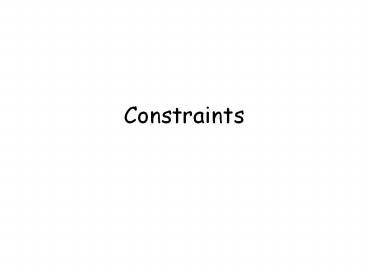Constraints PowerPoint PPT Presentation
Title: Constraints
1
Constraints
2
Primary Key Constraint
- It is derived from the entity UID or created as
surrogate key. - Uniqueness is enforced by an index
- Index is not defined in Oracle Designer
- All columns in key are mandatory.
- It should not be updatable.
- Every table should have one!
3
Unique Key Constraint
- Derived from secondary entity UIDs
- Can include NULL columns
- Are optional
- Recommended where a surrogate key is used for PK
4
Foreign Key Constraint
- Derived from relationships
- Can reference either a primary or a unique key
- But avoid referencing unique keys!
- Must not be partly NULL
- Can reference its own table
- Cannot reference tables on other databases
5
Foreign Key Rules
DEFAULT
NULLIFY
CASCADE
RESTRICT
(default)
X
- Server handles RESTRICT and CASCADE Delete only
6
Defining Foreign Key Rules
Foreign Key Properties
- Cascades
- Defaults
- Nullifies
- Restricted
Cascade Rules
Delete Rule
Update Rule
- Avoid using any update rule
- PKs should not be updatable
7
Check Constraint
CHECK ((position 'TECHNICAL' AND salary
BETWEEN 3000 AND 4000) OR (position !
'TECHNICAL'))
8
Foreign Keys in Arcs
DSD1
9
Implementing Subtypes
GAME and MOVIE subtypes in TITLES
TITLES
PRODUCT_CODE
CHECK ((TI_TYPE 'GA'AND GAME_CATEGORY IS NOT
NULLAND MEDIUM IS NOT NULL AND MOVIE_CATEGORY
IS NULL AND AGE_RATING IS NULL) OR ...
TI_TYPE
TITLE
MOVIE_CATEGORY
AGE_RATING
GAME_CATEGORY
MEDIUM
10
More Uses for Check Constraints
- START_DATE lt END_DATE
- Positive numeric column values gt 0
- IS NOT NULL
- Can only check columns within the same row use
triggers for more complex checks
11
Defining a Check Constraint
EMP_DEPT_FK
- Specify the Where/Validation condition
12
Where Are Constraints Validated?
- At the client, the server or both
- Considerations
- Database integrity
- Interactive response
- Network traffic
- Overall system performance
13
Specifying Location of Validation
14
Server Validation
Server
Client
Guaranteed integrity Minimal network traffic
No immediate feedback
15
Server and Client Validation
Server
Client
Guaranteed integrity Immediate feedback
Network traffic for every check
16
Client Validation
Server
Client
Immediate feedback
No guaranteed integrity Network traffic for
every check and again for DML or commit
17
Guidelines for Choosing Where to Validate
- Server validation
- Guaranteed data integrity
- Client and server validation
- Check constraints
- Lookup foreign keys
- Case-by-case basis
- Other foreign keys
- Unique keys
18
Controlling When to Enforce
Client
Server
- Typical transactions
- Oracle validates each DML statement.
- Complex transactions
- Oracle8 server can defer validation until COMMIT.
19
Specifying When Validation Occurs
When to enforce
20
Summary
- Constraints enforce data integrity
- Entity integrity
- Referential integrity
- Arcs, subtypes, and simple business rules
- Validation can be carried out
- Server and client
- Deferred

